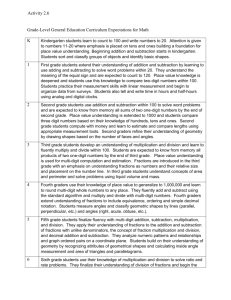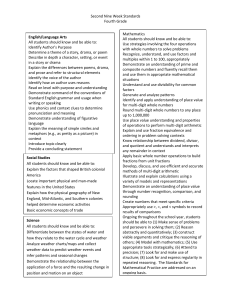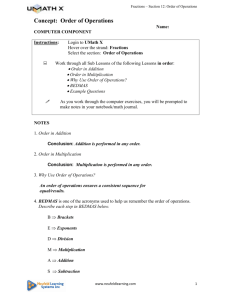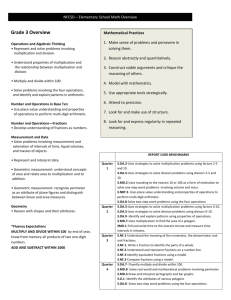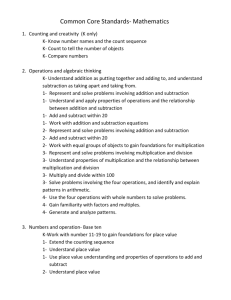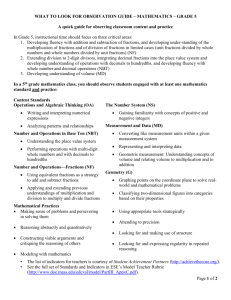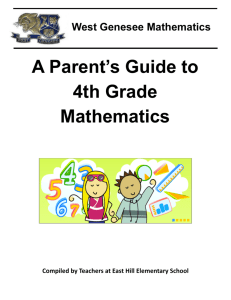Parent Summary Grade 4 - Baltimore County Public Schools
advertisement
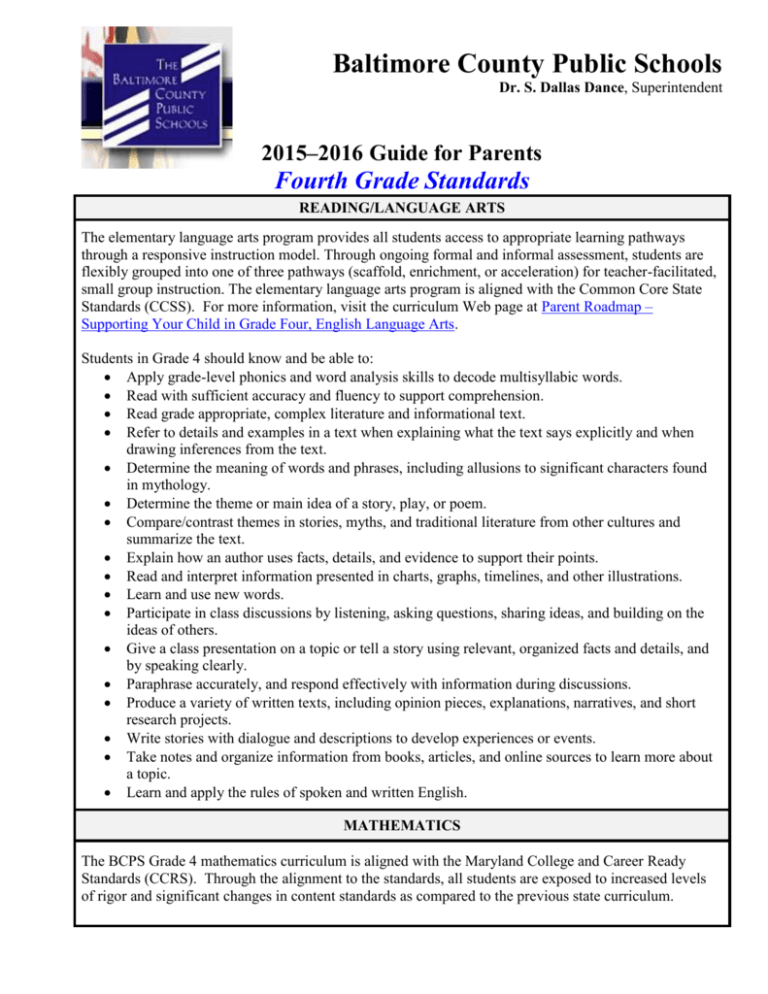
Baltimore County Public Schools Dr. S. Dallas Dance, Superintendent 2015–2016 Guide for Parents Fourth Grade Standards READING/LANGUAGE ARTS The elementary language arts program provides all students access to appropriate learning pathways through a responsive instruction model. Through ongoing formal and informal assessment, students are flexibly grouped into one of three pathways (scaffold, enrichment, or acceleration) for teacher-facilitated, small group instruction. The elementary language arts program is aligned with the Common Core State Standards (CCSS). For more information, visit the curriculum Web page at Parent Roadmap – Supporting Your Child in Grade Four, English Language Arts. Students in Grade 4 should know and be able to: Apply grade-level phonics and word analysis skills to decode multisyllabic words. Read with sufficient accuracy and fluency to support comprehension. Read grade appropriate, complex literature and informational text. Refer to details and examples in a text when explaining what the text says explicitly and when drawing inferences from the text. Determine the meaning of words and phrases, including allusions to significant characters found in mythology. Determine the theme or main idea of a story, play, or poem. Compare/contrast themes in stories, myths, and traditional literature from other cultures and summarize the text. Explain how an author uses facts, details, and evidence to support their points. Read and interpret information presented in charts, graphs, timelines, and other illustrations. Learn and use new words. Participate in class discussions by listening, asking questions, sharing ideas, and building on the ideas of others. Give a class presentation on a topic or tell a story using relevant, organized facts and details, and by speaking clearly. Paraphrase accurately, and respond effectively with information during discussions. Produce a variety of written texts, including opinion pieces, explanations, narratives, and short research projects. Write stories with dialogue and descriptions to develop experiences or events. Take notes and organize information from books, articles, and online sources to learn more about a topic. Learn and apply the rules of spoken and written English. MATHEMATICS The BCPS Grade 4 mathematics curriculum is aligned with the Maryland College and Career Ready Standards (CCRS). Through the alignment to the standards, all students are exposed to increased levels of rigor and significant changes in content standards as compared to the previous state curriculum. MATHEMATICS (Continued) The Grade 4 advanced mathematics curriculum is also a CCRS-aligned mathematics program which is extended into the Grade 5 CCRS expectations where appropriate. Advanced and high-potential students learn all of the Grade 4 and part of the Grade 5 mathematics CCRS. Multiple opportunities for formative assessment exist throughout the curriculum, to provide access and opportunity to all students. The Grade 4 elementary mathematics curriculum focuses on three critical areas: 1. Developing understanding and fluency with multi-digit multiplication and division. 2. Developing an understanding of fraction equivalence, addition and subtraction of fractions, and multiplication of fractions by whole numbers. 3. Understanding that geometric figures can be analyzed and classified based on their properties. Students in Grade 4 should know and be able to: Use addition, subtraction, multiplication, and division to solve a variety of problems. Understand that multiplication can represent a multiplicative comparison. Use manipulatives, pictures, and equations to solve multiplication and division problems. Solve multi-step, real-world problems involving addition, subtraction, multiplication, and division. Interpret remainders in division story problems. Gain familiarity with factors and multiples. Determine if numbers are prime or composite. Generate a number or shape pattern that follows a given rule and identify features of the pattern. Read, write, and represent multi-digit whole number up to one million. Understand how the base ten number system works. Use place value understanding and properties of operations to perform multi-digit computation. Fluently add and subtract multi-digit whole numbers using the standard algorithm. Fluency, or knowing from memory, develops with the use of reasoning strategies rather than through rote memorization.* Multiply a whole number with up to four-digits by a one-digit number. Multiply a two-digit number by a two-digit number. Divide a four-digit number by a one-digit number. Use area models to show how to multiply and divide multi-digit numbers. Extend understanding of ordering and comparing fractions. Generate equivalent fractions. Add and subtract fractions with like denominators using manipulatives, pictures, diagrams, numbers, and words. Decompose a fraction into a sum of multiple fractions. Add and subtract mixed numbers. Solve a variety of word problems involving addition and subtraction of fractions. Multiply a fraction by a whole number. Understand how fractions and decimals are related. Read, write, and represent decimal fractions up to hundredths. Compare decimals using >, <, or =. Solve problems involving measurement conversions and addition, subtraction, multiplication, and division. MATHEMATICS (Continued) Solve real-world area and perimeter problems using formulas. Make a line plot and interpret the data. Understand the concept of angles and how to measure them. Understand how an angle measure is related to circular rotation. Recognize that angle measurement is additive. Draw and identify lines, angles, and classify shapes by the properties of their lines and angles. Recognize lines of symmetry in shapes. *Grade level fluency expectation. SCIENCE The elementary science curriculum includes content in the areas of Earth/Space Science, Physical Science, and Environmental Science, and incorporates the skills and processes of science. For more information, visit the curriculum Web page at http://www.bcps.org/offices/science/parents.html. Students in Grade 4 should know and be able to: Recognize and explain that the rotation of the earth produces the day and night cycle. Describe how celestial objects in the solar system differ in regard to their properties, location, and patterns of movement and change. Identify and explain the relationship among the sun and planets in the solar system. Recognize and describe the predictable patterns of tides. Identify and describe that matter undergoes physical and chemical changes. Recognize and explain that matter has structure. Recognize and explain that the earth’s surface features and environmental conditions limit what types of organisms can survive. Recognize and explain how renewable natural resources are used by humans to meet basic needs. Access and process information from readings, investigations, and oral communications. Analyze and develop a well-designed investigation. Identify and demonstrate safe procedures when conducting an investigation. Communicate findings from hands-on investigations and print/non-print resources. Describe and compare similarities and differences among objects and materials and scientific concepts. Apply scientific concepts to make decisions about a relevant science issue. Recognize and explain that the use of technology extends the ability to do work and solve problems. SOCIAL STUDIES Social studies instruction is intended to provide the knowledge of content and appropriate skills so students can become active, involved citizens of the community. The Grade 4 curriculum leads students into a deeper exploration of the history of the United States. Students will use the foundational skills in geography, economics, political science, and culture to analyze the events of the Age of Exploration and the early Colonial Period. The Grade 4 units of study include: 1. Geography and Economics in the United States 2. The Earliest Americans 3. Age of Encounters 4. The English Colonies. SOCIAL STUDIES (Continued) Students in Grade 4 should know and be able to: Analyze and evaluate the impact of the geography on the people of the United States in general, and Maryland in particular. Analyze personal financial decisions, goals, and institutions. Analyze and evaluate the impact of geography Native American cultures. Analyze goals and consequences of European exploration and settlement of North America. Compare early colonial life in Maryland to other colonies. HEALTH Health instruction is designed to provide the functional knowledge and skills to enhance health and wellbeing. Students in Grade 4 should know and be able to: Recognize and model effective communication skills. Recognize how emotions influence behaviors. Identify components to promote personal well-being. Demonstrate the ability to locate resources that provide valid health information concerning consumer health issues and services. Demonstrate the ability to identify and practice health-enhancing behaviors to reduce health risks and live safer, healthier lives. Identify harassment as a form of violence. Identify safety rules that will prevent injury or accidents in specific situations. Identify the steps in the decision-making process. Explain the relationship between fitness and a healthy lifestyle. Describe and analyze the Nutrition Facts Label. PHYSICAL EDUCATION The physical education program focuses on developing physically literate students. The content includes skill development in body and spatial awareness; fundamental and creative movement; rhythms and dance; tumbling and gymnastics; and fitness. Students in Grade 4 should know and be able to: Create routines using a combination of skills in a variety of physical activities. Apply rules and offensive/defensive strategies and tactics in a game situation. Participate in FITNESSGRAM fitness testing to assess personal Healthy Fitness Zones (HFZ). Demonstrate and identify exercises that directly relate to each of the health-related fitness components. Examine and compare the health benefits of participating in a variety of physical activities. LIBRARY MEDIA The library media program is aligned with the Maryland College and Career Ready Standards and the Standards for the 21st Century Learner. Students in Grade 4 should know and be able to: Communicate conclusions to various audiences by choosing the most effective media format using a variety of technology tools. LIBRARY MEDIA (Continued) Use the Internet, digital content, and technology tools to efficiently and effectively locate, explore, gather, evaluate, organize, synthesize, and communicate information using a variety of media formats. Read, comprehend, analyze, and evaluate literary texts and media including plays, poems, fantasy, realistic fiction, historic fiction, fables, and fairy tales. Read, comprehend, interpret, summarize, analyze, and evaluate a variety of informational texts and media including biographies, diaries, articles, textbooks, primary documents, digital content, and Internet resources. Discover the pleasure of reading, listening, and viewing a variety of printed and digital texts. Apply understanding of how information is organized in print, media, and digital contexts. Generate compelling questions and effective search strategies to find answers to academic and personal questions. Evaluate information resources by applying criteria, e.g., authority, scope, timeliness, objectivity, and ease of use. Use the Web-based, Online Public Access Catalog from school and home to locate library and Internet resources to solve problems, answer questions, and select resources that support learning and personal interests. Practice safe, ethical, and responsible use of information and technology. Exhibit respect for the intellectual property rights (copyright) by paraphrasing ideas of others and citing sources of text and digital information used to communicate new knowledge. MUSIC The elementary music program is a comprehensive program of instruction aligned to the Maryland Essential Learner Outcomes for Fine Arts. Music content and skills are sequentially developed from prekindergarten through Grade 5. In addition to general music, students in fourth grade participate in an exploratory instrumental music program. Students in Grade 4 should know and be able to: Identify and perform rhythmic and melodic notation. Analyze the structure and form of musical compositions. Perform in harmony through singing and playing instruments. Classify instruments of the orchestra by families. Perform basic skills on the clarinet, violin, and trumpet. VISUAL ARTS The fourth grade visual arts program focuses on experimenting and analyzing. Students in Grade 4 should know and be able to: Interpret the environment through analyzing qualities of form that can be seen and felt. Seek creative solutions for solving art problems. Identify ways the study of artists’ works can provide new ideas for art expression. Identify ways that the works of artists communicate beliefs and values of individuals and cultures. SPECIAL NOTE: Technology is integrated into all subject areas to enhance opportunities for collaboration, creativity, and innovation. Effective technology integration prepares students to connect problem-solving, critical-thinking, and communication skills to their intellectual growth.
